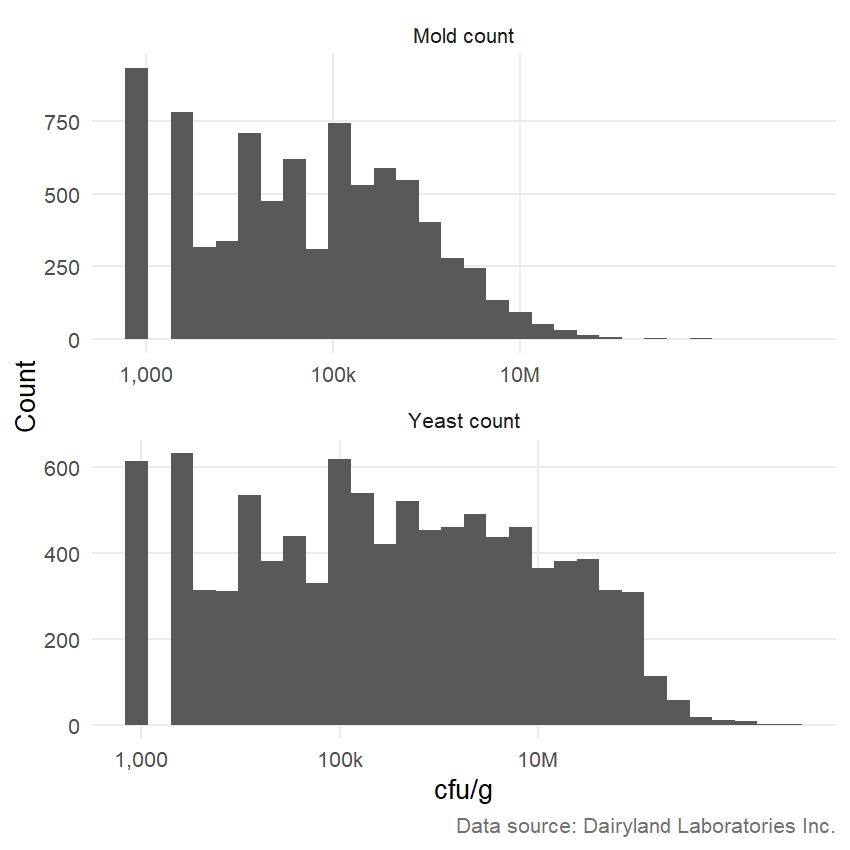Mold and yeast consume feed nutrients and impact livestock performance by inhibiting rumen function, producing mycotoxins, and reducing aerobic stability.
Did You Know?

30% of samples tested contain less than:
- 1,000 cfu/g of mold
- 10,000 cfu/g of yeast

For example, fusarium mold grows prolifically at 75-85°F without producing much mycotoxins, but when temperatures approach freezing, they produce large quantities of mycotoxin with minimal mold growth. (Joffe, 1986)
To measure mycotoxin risk, analyze for mycotoxins directly. Visit Dairyland's Mycotoxin Page for more testing solutions and interpretations.

30% of samples tested contain more than:
- 60,000 cfu/g of mold
- 900,000 cfu/g of yeast
Clean feeds do not contain detectable levels of mold and yeast
More mold does not equal more toxins
Mold and yeast grow exponentially
Mold species
Color
Toxin
Conditions favoring production
Aspergillus
Yellow-green
Aflatoxin
Ochratoxin
Citrinin
Heat and drought stress pre-harvest. Heat and humidity post harvest.
Fusarium
White to pinkish-white
Zearalenone
T-2/HT-2
Vomitoxin(DON)
Fumonisin
Fusaric acid
Associated with ear and stalk rot in corn, head scab in small grains, red ear rot, pink ear rot.
Penicillium
Green to green-blue
Ochratoxin
Cool, wet, and low pH (acid tolerant) post harvest.
Cladosporium
Dark blue-green to gray or black, white
None
Early frost, neutral pH, high grain moisture (30-40%), temperatures at 75-125°F. Commonly invades corn after premature frost.
Mucor
Grey-white
None
Grows at low temperatures, typically in storage.
Rhizopus
Grey-white
None
High moisture and advanced decay.
Under 500,000
500,000 - 1 million
1 to 2 million
2 to 3 million
3 to 5 million
Over 5 million
Feeding risk and cautions
Relatively low count
Relatively safe
Discount energy (x .95). Feed with caution.
Closely observe animals and performance. Discount energy (x .95)
Dilute with other feeds. Discount energy (x .95). Observe closely.
Discontinue feeding
a Risks refer primarily to effects of mold per se without regard to possible mycotoxin content. Depressed digestibility, feed intake, and performance may occur from a high mold content without mycotoxins present. Harmful mycotoxins may be present, even when there is little or no obvious mold content.
b Mold spore counts may sometimes underestimate the degree of mold present, especially in feeds that have been ensiled for some weeks. Observe and record relative amounts of mold present.
References +
Joffe, A.Z. 1986. "Fusarium Species: Their Biology and Toxicology". John Wiley and Sons, Inc. New York.
Kurtzman, C.P., B.W. Horn, and C.W. Hesseltine. 1987. Aspergillus nomius, a new aflatoxin-producing species related to Aspergillus flavus and Aspergillus tamarii. Anton v. Leeuwenhoek 53:147-158.
Adams, Richard S., Kenneth B. Kephart, Virginia A. Ishler, Lawrence J. Hutchinson, and Gregory W. Roth. "Mold and Mycotoxin Problems in Livestock Feeding." Dairy Cattle Nutrition (Penn State Extension). Penn State Extension, n.d. Web. 17 Sept. 2013.
Hoffman, P., R. Shaver, and P. Esker. 2009. High moisture corn, aerobic stability, feed additives, and mycotoxins: Common questions. The 2009 Wisconsin Corn Corp.
Wright, C., B. Holland, R. Daly and L. Osborne. 2009. Moldy corn for beef cattle. SDSU Extension Extra: 2069.
TESTING SERVICES
Dairy & Beef Nutrition
Mill Quality Assurance
Hay Testing
Water
Forage Superbowl
© 2024 Dairyland Laboratories, Inc.
SUPPORT SERVICES
Affiliate Labs
R & D
Portable NIR
NIR Packages




